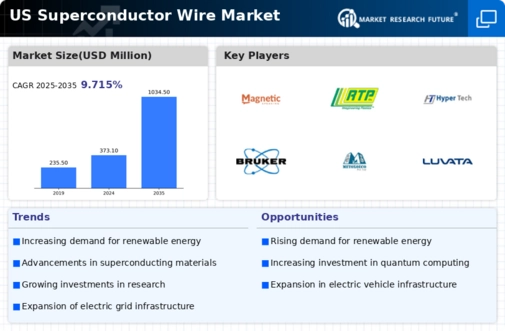Increased Focus on Electric Vehicles
The superconductor wire market is witnessing growth. This growth is driven by the rising focus on electric vehicles (EVs). Superconducting wires can potentially enhance the efficiency of electric motors and power electronics used in EVs, leading to improved performance and reduced energy consumption. As the US government promotes the adoption of EVs through incentives and infrastructure development, the demand for superconducting technologies is expected to rise. The EV market in the US is projected to reach approximately $800 billion by 2030, with superconducting materials playing a vital role in achieving the performance targets set by manufacturers. This trend indicates a promising future for the superconductor wire market as it aligns with the broader shift towards sustainable transportation.
Expansion of High-Performance Computing
The superconductor wire market is being driven by the expansion of high-performance computing (HPC) systems. Superconducting wires are integral to the development of quantum computers and advanced supercomputers, which require efficient and high-speed data processing capabilities. The US is at the forefront of HPC research, with significant investments being made to enhance computational power for various applications, including artificial intelligence and big data analytics. The HPC market is expected to grow to over $50 billion by 2027, with superconducting technologies being a key component in this evolution. As the demand for faster and more efficient computing solutions increases, the superconductor wire market is likely to experience substantial growth.
Rising Applications in Renewable Energy
The superconductor wire market is experiencing a notable surge in demand due to its increasing applications in renewable energy systems. As the US transitions towards sustainable energy sources, superconducting materials are being integrated into wind and solar power systems to enhance efficiency. For instance, superconducting wires can significantly reduce energy losses in power transmission, which is crucial for maximizing the output of renewable energy installations. The market for superconducting wires in renewable energy applications was projected to grow at a CAGR of approximately 15% over the next five years, indicating a robust expansion in this sector. This trend underscores the pivotal role of superconductor wire technology in achieving energy efficiency and sustainability goals, thereby driving growth in the superconductor wire market.
Advancements in Medical Imaging Technologies
The superconductor wire market is being propelled by advancements in medical imaging technologies. This is particularly true for magnetic resonance imaging (MRI) systems. Superconducting wires are essential for creating powerful magnets that enhance the resolution and speed of MRI scans. The increasing prevalence of chronic diseases and the demand for advanced diagnostic tools are driving the adoption of MRI systems, which in turn boosts the demand for superconducting wires. The US medical imaging market is expected to reach approximately $50 billion by 2026, with superconducting technologies playing a crucial role in this growth. As healthcare providers seek to improve patient outcomes through better imaging techniques, the superconductor wire market is likely to benefit significantly from this trend.
Growing Investment in Research and Development
Investment in research and development (R&D) within the superconductor wire market is a critical driver of innovation and growth. Numerous US-based companies and research institutions are focusing on developing new superconducting materials and improving existing technologies. This investment is aimed at enhancing the performance and reducing the costs associated with superconducting wires. For example, the US government has allocated substantial funding for R&D initiatives in superconductivity, which is expected to exceed $200 million annually. This influx of capital is likely to accelerate advancements in the superconductor wire market, fostering the development of next-generation applications across various industries, including energy, transportation, and healthcare.




















Leave a Comment